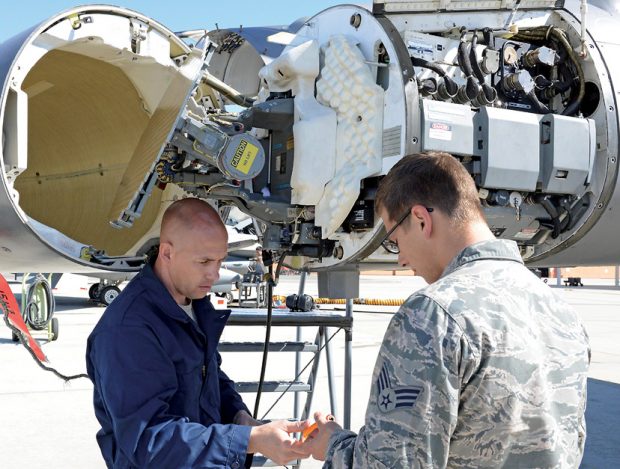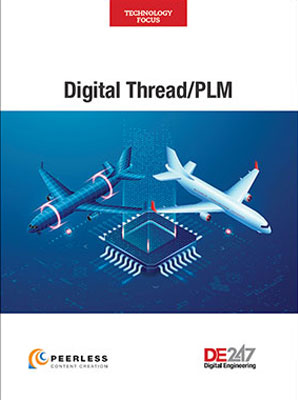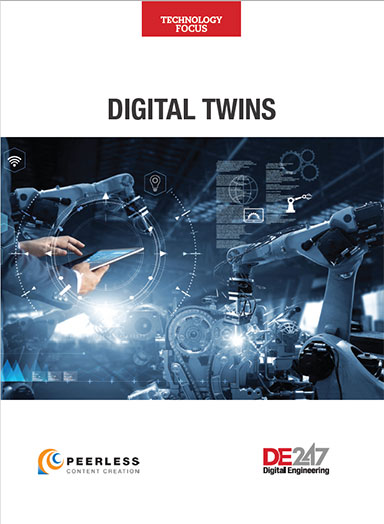Digitalization: If Every ‘Thing’ is Connected, Who Owns the Data?
Latest News
July 1, 2018
Industrial digitalization is transforming manufactured products into smart products. Automobiles and aircraft, for example, are quickly becoming computers with mobility. Moving human involvement from direct navigation to remote operation (drones, self-driving cars) is the most obvious result of how digitalized, smart products change the operational model.
Digitalization in product development is also relocating direct human involvement in maintenance and operations. Built-in IT allows products to perform self-analysis and to report out valuable operational data, changing human involvement to a more executive role of overseeing the automated process of deciding when a part is under stress, needs maintenance or should be replaced. Such analytic parts must be designed for connectivity and sharing—which opens up management and control issues between vendors and product owners.
 Two members of the U.S. Air Force do pressurization maintenance on an F-16 Fighting Falcon radar waveguide. Such maintenance is now done based on pre-established rules such as hours of use, but newer aircraft are being delivered with the capability to self-report maintenance needs using sophisticated IoT-based sensors. Image courtesy of the U.S. Air Force; Kenji Thuloweit, photographer.
Two members of the U.S. Air Force do pressurization maintenance on an F-16 Fighting Falcon radar waveguide. Such maintenance is now done based on pre-established rules such as hours of use, but newer aircraft are being delivered with the capability to self-report maintenance needs using sophisticated IoT-based sensors. Image courtesy of the U.S. Air Force; Kenji Thuloweit, photographer.Just as operational models are changing, so too are the business models that deliver products and services. Is an aerospace vendor obligated to provide IT support for an airplane? If a vendor wants to sell services around product data retrieval, does that mean the vendor is claiming ownership of the data? Should products be sold as physical product only, with full digitalization only available for an extra fee? Right now there are no simple answers.
Take the case of the U.S. Air Force as an example. It wants to use operational data to predict when its cargo and refueling aircraft need maintenance or part replacement. Their newer aircraft have the capability to monitor and send the necessary data, but they can’t do it under existing contracts. The Air Force owns the jets, but the rights to diagnostic information are controlled by the primary vendors of airframes and engines. “I want to own the data,” says Gen. Carlton Everhart, who leads Air Mobility Command. “Our airplanes have the capability right now; all I have to do is put it on contract,” the general said at an Air Force Association conference last year. “We have the capability; we just didn’t buy the capability.”
In the case of the Air Force, the contractors are Boeing and Lockheed Martin for the airframes, and Pratt & Whitney and General Electric for the engines. There is no question the vendors want to work with the military; it is just a matter of contractual agreements and determining what both sides consider as fair compensation. Because it is for military use, there are special complications, the most obvious of which is security. Any data passing between aircraft and operations must be secure. Everhart thinks it could be several years before he is able to gather the money required to move real-time information to the ground.
The cost of full access to aircraft data will be worth it, Everhart says. He cited the example of a commercial aircraft “telling on itself” by reporting out that it would need maintenance in 40 hours. So the engine was changed out before it flew again. It was only after the swap that a nick was discovered in a fan blade. The estimated cost savings of changing the engine before it failed was $50 million.
The European Union is watching how data ownership and access is changing industrial relationships. An April 2018 study examines the notion that the value of data increases with its aggregation level. Contractual agreements are already in use to control how product data is gathered and used, but the EU is concerned contracts alone may not lead to “broad and fair access to data held,” especially when smaller companies buy products from very large vendors. Small companies want to “valorize” their product data—create value from its use. But relying on contracts alone, the report claims, does not settle many issues. There would be no standards on the definition of intellectual property (IP) and trade secrets as they impact data analytics.
Digitalization Offers High-Stakes Potential
The potential rewards of fully digitalized product data are high, which means there is no lack of companies bringing solutions to market. C3 IoT was created by Thomas Siebel, best known for Siebel CRM Systems, a large database software company acquired by Oracle in 2005. C3 IoT offers data analytics for many industry segments including aerospace and defense. It now has product trials underway, analyzing data from flight records, maintenance logs, sensors and crew observations. “Based on initial results, we think we can improve aircraft availability by at least 25%,” C3 IoT President Ed Abbo told Bloomberg Government. The 2018 Air Force budget for operations and maintenance (O&M) is approximately $45 billion. Every percentage point of improved aircraft availability would trim hundreds of millions of dollars from operational costs.
A recent Accenture Consulting study on data ownership and access models in aerospace and defense reveals two predominant streams of thought in industry. The first is coordination among multiple players (original equipment manufacturers, supply chain and IT providers). The second is central management of data as a comprehensive digital thread. In a survey of A&D companies, 87% see supplier and IP management for both hardware and software as a key aspect of creating and using digital thread technology in the next three years. Accenture sees this current state of data usage as raising more questions than it answers, specifically surrounding data standardization, sharing, IP control and incentives for compliance.
The Accenture survey revealed only 27% of A&D firms have shared ownership of the digital thread and or the digital twin across their IT and business functions. “Of all the enterprise systems and processes, this is an area where a true symbiotic commitment is fundamental,” the Accenture report notes. “While there are clear technical components involved in developing the right systems and protocols, insights that result in effective monetization will necessarily come from the business.”
Accenture is not the only company that suggests data issues transcend engineering. David Knight is founder and CEO of Terbine, a startup for curating industrial physical data from manufacturing to consumer use. “As a rule of thumb, whomever holds title to the data producing platform, likely owns the data,” notes Knight. But there are many uncertainties. “The common denominator is well-crafted contractual language that both protects consumer interests and feeds a growing data ecosystem.”
In a study prepared for IEEE, two Bell Laboratories (Alcatel-Lucent) scientists outline how they see multiple models of data ownership evolving. The first is pay per use. The product becomes part of a provided service agreement and the contract allows the manufacturer data access and use rights in exchange for charging for use of the product based on usage data. The second data ownership model is data market. Those who purchase a product offer the data it generates as a commodity, either to the original manufacturer, a vendor or other parties. The third data ownership model is open data model, for situations like driving, where the data creation takes place in a public space. Such a space would include a notion of intention integrity, meaning device owners must have equal access to the data with manufacturers and public agencies, and the use of the data must be explicitly defined.
Subscribe to our FREE magazine, FREE email newsletters or both!
Latest News
About the Author
Randall S. Newton is principal analyst at Consilia Vektor, covering engineering technology. He has been part of the computer graphics industry in a variety of roles since 1985.
Follow DE





